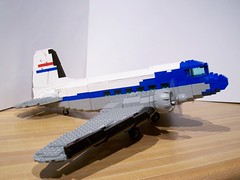When my father left the Navy and joined United Air Lines in the late 1950’s, he flew this plane, the DC-3.

Like my Lunar Mobile Lounge, this has been at several BayLUG meetings, and now I am finally posting about it here.
Also like that model, it is motorized. There are two motors, located in the fuselage: one which powers the propellers and the other which makes the landing gear go up and down. There is a battery box in the fuselage that powers the propellers, and a wire coming out of the entry door leading to a battery box that controls the landing gear. In both cases, a Technic axle passes through the fuselage and the base of each wing. For the props, there are bevel gears in each engine which drive the propshafts. For the landing gear, the axle is mounted directly to the mechanism. A roof panel is removable to view the mechanism inside. Here’s a video I made to illustrate how it works (it’s also available as a QuickTime movie on Brickshelf):
There are other parts that move as well: the ailerons, elevators, and rudder are all freely hinged. Oh, and the wheels rotate :-) The wings and vertical tail can be removed easily for storage and transportation.
The fuselage is designed using half-stud offsets to achieve the desired shape. This means the walls are very fragile as they cannot be properly interconnected.
On the leading edge of each wing are “de-icing boots” which are made of rubber in the real plane. These are modeled using a curved brick that I got at LEGOLAND California in their “build it and buy it” area in 2003. I don’t know if they were ever part of an official LEGO set, but I never saw them anywhere else. It’s the same shape as the trans-light-blue spotlights in the Soccer sets. These “boots” are attached at an angle using plate hinges and plates, and have half-stud offsets to follow the desired wing angle.
Overall this was an interesting experiment in half-stud offsets and integrating a Technic mechanism into a realistic looking model. I learned a lot making this and hope you enjoy it.
Click the photo above to see more, or click to look on Flickr (slideshow) or on Brickshelf.
